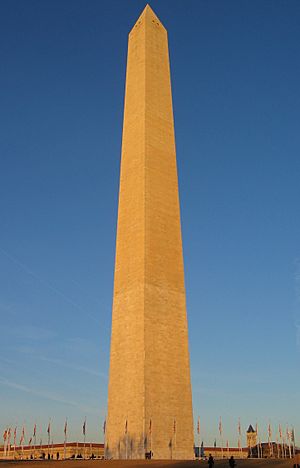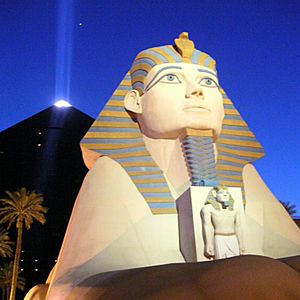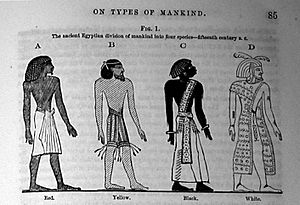Egyptomania in the United States facts for kids
Egyptomania is a cool word for when people became super interested in the culture of ancient Egypt. This big wave of interest started in the 1800s. It all began after Napoleon's army went to Egypt in 1798.
Napoleon didn't just bring soldiers; he also brought many scientists and smart people. They carefully studied and wrote about the ancient Egyptian buildings and monuments. This made everyone back home very curious about Egypt.
A big moment happened in 1822. A French scholar named Jean-François Champollion finally figured out how to read ancient Egyptian writing, called hieroglyphs. He used the Rosetta Stone, which Napoleon's soldiers had found in 1799. This discovery was huge! It meant people could now truly understand ancient Egypt, and that's when the scientific study of egyptology really took off.
People showed their love for ancient Egypt in many ways. You could see it in books, buildings, art, movies, and even how people dressed. Not many people could actually travel to Egypt back then. So, they learned about this amazing culture through books, art, and buildings. Famous works like Vivant Denon's Voyage dans la Basse et la Haute Égypte and Giuseppe Verdi's opera Aida helped spread the excitement.
Egyptian designs became very popular in art and decorations, especially in France. You could find Egyptian-style patterns on fancy dishes, furniture, and even everyday items. People even threw parties with an Egyptian theme and wore special costumes! This style of building, called Egyptian Revival architecture, was popular throughout the 1800s and into the 1900s. The discovery of King Tut's tomb in 1922 made everyone even more excited about ancient Egypt.
Contents
Egypt's Influence in America


In America, people also loved ancient Egypt. They used Egyptian ideas in their books, art, and buildings. These ideas often helped them talk about important topics like national identity and fairness.
Some Egyptian symbols became very powerful. For example, the mummy fascinated Americans. People were curious about the idea of life after death. Sometimes, people even had "mummy unwrapping" events!
The famous queen Cleopatra, mysterious hieroglyphic writing, and pyramids as mazes also captured people's imaginations. Many American writers used these ideas in their stories. Think of "Some Words With a Mummy" by E. A. Poe or "Lost in a Pyramid, or The Mummy's Curse" by Louisa May Alcott.
The impact of ancient Egypt on buildings in the United States is called the Egyptian Revival. This style used Egyptian images, shapes, and symbols. You can see it a lot in old cemeteries. Things like tall, pointed obelisks were used as headstones, and sphinx statues guarded gates.
For example, the entrance to the Mount Auburn Cemetery in Boston and the Grove Street Cemetery in New Haven, Connecticut, were built in the Egyptian Revival style. Other famous examples include the Gold Pyramid House in Illinois and the Washington Monument in Washington, D.C., which is a giant obelisk.
Even today, ancient Egypt is popular. Movies like The Mummy (and its older version from 1932) show that people are still excited about discovering Egypt's secrets.
It's important to know that fascination with Egypt didn't start with Napoleon. Ancient Greeks and Romans were also interested! When the Roman Emperor Augustus conquered Egypt in 31 BCE, Roman people became very curious. They built things like a pyramid-shaped tomb for a high official named Caius Cestius. Emperor Hadrian even honored his deceased friend by linking him to the Egyptian god of the afterlife, Osiris.
Science and Society
In the 1800s, some scientists studied human skulls. This study was called Craniology. They wrongly believed they could tell how smart someone was or what their personality was like by looking at their skull. Egyptian mummies were sometimes used for these studies.
A key figure was Samuel George Morton. He wrongly claimed that there were different human "races" and that they were in a hierarchy, with white people at the top. This idea, called Polygenesis, is not supported by science today.
Even though Morton's ideas about race were wrong, his work did help change how science was done at the time. It moved science away from older religious ideas about how humans came to be.
Identity in the United States
Ancient Egypt has been seen as a place that belongs to "everyone's past." This made it important for how different groups of people in the Western world, especially in the United States, thought about their own identity.
In the 1800s, as America was figuring out its national identity, there was also a big conflict over slavery. Some people tried to use ideas about race and ancient Egypt to justify slavery and unfair treatment. They wrongly claimed that white people were the "natural" Americans.
Scientists like Samuel George Morton used ideas about the race of Egyptian pharaohs to support these unfair ideas about race in America. This was used to justify treating enslaved people badly and denying rights to anyone who wasn't white.
A book called Types of Mankind (1854) even had a chapter on the "racial characteristics" of ancient Egyptians. This started a big debate about whether ancient Egyptians were white, black, or a mix. People looked at wall paintings or mummies to try and prove their points. Today, scientists and historians agree that these old ideas about fixed "races" are not accurate.
African American Culture
In the 1800s, some African American thinkers said that the ancient Egyptians were black Africans. This was a powerful idea. It helped provide a long and noble history for black people, which was important because racist ideas at the time tried to make them seem less important. Important figures like David Walker, James McCune Smith, Frederick Douglass, and W. E. B. Du Bois were part of this discussion.
See also
 In Spanish: Egiptomanía para niños
In Spanish: Egiptomanía para niños
- List of pyramid mausoleums in North America





